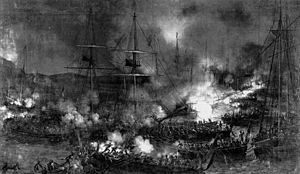Raids on Boulogne facts for kids
Quick facts for kids Raid on Boulogne |
|||||||
|---|---|---|---|---|---|---|---|
| Part of the naval operations during the War of the Second Coalition | |||||||
 Nelson fails against the flotilla near Boulogne - 15th of August 1801, by Louis-Philippe Crépin (1772 Paris – 1851) |
|||||||
|
|||||||
| Belligerents | |||||||
| Commanders and leaders | |||||||
| Strength | |||||||
| 6 ships of the line 7 frigates 11 sloops-of-war 7 bomb vessels 32 brigs large number of gunboats |
24 brigs and lugger-rigged flats 1 schooner |
||||||
| Casualties and losses | |||||||
| 44 killed 126 wounded 6 gunboats sunk 20 captured 4 deserted |
10 killed 30 wounded 2-4 luggers sunk |
||||||
The raid on Boulogne in 1801 was a failed attempt by the British Royal Navy. It was led by Vice Admiral Horatio Nelson. The goal was to destroy French ships in the port of Boulogne. These ships were thought to be part of a plan to invade England. This event happened during the French Revolutionary Wars.
On August 4, Nelson ordered five special ships called bomb vessels to attack. They fired many shots at the French ships. But the French fought back well. The British had more injuries and had to leave. Nelson returned on the night of August 16. He tried to capture the French ships with 70 boats and almost 2,000 men. However, the French, led by Admiral Latouche Tréville, successfully stopped the attack.
Contents
Why the Raid Happened
In 1801, a war on land between France and Austria ended. This meant France controlled more areas in Europe. At the same time, peace talks between Britain and France were happening. But these talks were slow.
Because of this, French armies gathered at ports along the English Channel. They started preparing for a possible invasion of Britain. On July 12, Napoleon ordered many gun-vessels and soldiers to gather at Boulogne. Admiral Latouche Tréville was put in charge. He trained the troops for sea battles and boarding ships.
French Invasion Plans
French newspapers, like Le Moniteur, wrote about these invasion plans. They even printed Napoleon's threats. But in reality, Napoleon just wanted to scare the British. He hoped they would agree to a peace treaty that favored France.
The British didn't fully believe an invasion would happen. Still, they brought back old defense plans from 1797. They sent more ships to the Channel Islands. In southern England, cattle were moved inland, and main roads were blocked.
Nelson's Role
Horatio Nelson had just returned from another battle. He was given orders to defend the British coast. His job was also to block or destroy French ships in their ports. All information pointed to Boulogne as the main gathering spot for French invasion ships. So, Nelson sailed there.
First Attack on Boulogne
Nelson arrived at Boulogne on the evening of August 3. He had his flagship, the frigate HMS Medusa, and 28 gunboats and five bomb vessels. He placed his ships about 3 kilometers from the port. This was far enough to be out of range of French land batteries.
The Bombardment
At 5 AM the next day, the bomb vessels began their attack. They fired at the French ships for 16 hours. They shot between 750 and 848 times. The French couldn't fire back much because their gunpowder was poor. Admiral Latouche Tréville thought about sailing closer to attack the British. But he decided against it because his gunboats were not well built.
Nelson saw that his bombardment wasn't doing much damage. So, he returned to England. He reported that three French ships and a brig were sunk. He also said several others were pushed ashore. However, Latouche Tréville only admitted two gunboats were sunk. One of them was later recovered. The British lost 4 or 5 men and two gunboats. One British gunboat exploded when its mortar broke. After this first attack, Nelson realized the French ships were not a serious threat.
Second Attack on Boulogne
For his second attack, Nelson couldn't surprise the French with a bombardment. The first attack had made them ready. Admiral Latouche-Tréville had added three battalions of soldiers to his ships. He also put up nets to stop British sailors from boarding. Nelson decided to try a surprise night attack instead. He had done this before in the Battle of Santa Cruz de Tenerife (1797).
Planning the Night Raid
Nelson organized four groups of boats for the attack. Captains Philip Somerville, Edward Thornborough Parker, Isaac Cotgrave, and Robert Jones led these groups. Another group of mortar-boats was led by Captain John Conn. Their goal was to capture the French ships.
Around 11:30 PM, the four groups of boats left the Medusa. They had been tied together to cross the Channel. But in the dark, moonless night, they lost sight of each other. The tides also pushed them apart. Robert Jones's group was swept past the French ships and didn't see any fighting. The other three groups attacked different parts of the French line. They attacked separately and at different times.
Somerville's Division
Captain Somerville's group was swept east of Boulogne bay by the current. He realized they couldn't attack in the planned order. So, he told the boats to untie and move more easily. Just before dawn, some of his leading boats attacked a French brig near Boulogne pier. They tried to pull it away, but it was held by chains that couldn't be cut. The French fired heavily with musketry and grapeshot from shore defenses. Three luggers and a second brig also fired. Somerville's forces had to retreat, leaving the brig behind.

